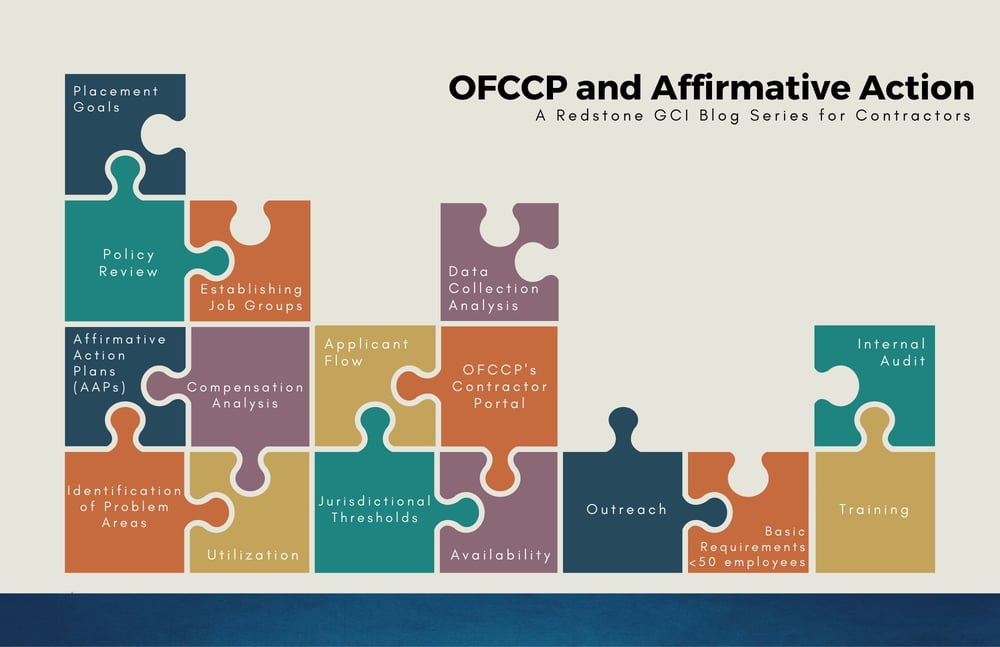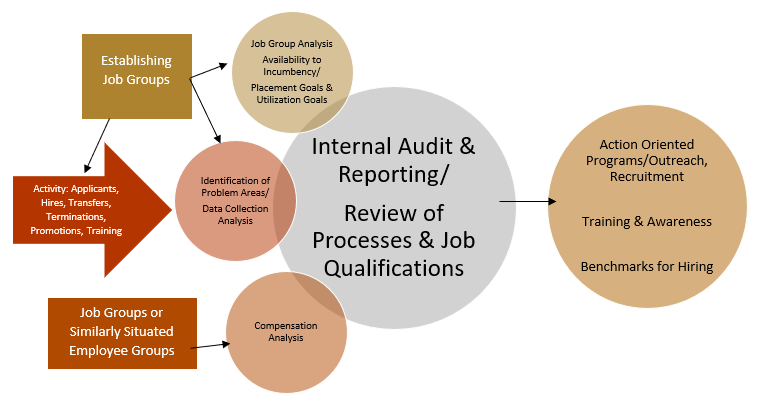
This article is under review as a result of EO 14173, Ending Illegal Discrimination and Restoring Merit-Based Opportunity, signed by President Trump on January 21, 2025. As we await further information from OFCCP and the courts, please reference this article for current status and action items.
In the previous blog of this series, we focused on the requirements of federal government contractors (prime and subcontractors) who meet the basic threshold requirements (specific dollar thresholds and fewer than 50 employees). As we progress in this series on OFCCP and Affirmative Action Requirements, we begin to dive into OFCCP’s expectations of a contractor’s Affirmative Action Program (AAP). As a reminder, contractors are required to have an AAP when meeting the dollar thresholds mentioned above and have an employee count of 50 or more.
|
AAP Requirements |
EO 11246 |
Section 503 |
VEVRAA |
|
Designation of Responsibility |
X |
X |
X |
|
Assign responsibility of Equal Employment and Affirmative Action responsibilities to an official of the organization. This employee is responsible for the development, implementation, and monitoring of all aspects of the Affirmative Action Program. |
|||
|
Annual Reporting |
X |
|
|
|
EEO-1 reporting is to be submitted annually and includes data related to the race/ethnicity and gender of the workforce by EEO-1 job category. Note that the reporting deadline for submitting 2021 EEO-1 Component 1 reports is Tuesday, May 17, 2022. As a reminder, VETS-4212 reporting is an annual requirement of contractors prior to having 50 employees and is therefore included in the Basic Requirements chart of a previous blog. |
|||
|
Recordkeeping & Retention |
X |
X |
X |
|
This topic was also addressed in the Basic Requirements chart of a previous blog. As a reminder, personnel and employment records related to all phases of employment must be maintained for one to two years from the time the record was made or action was taken, whichever is later. The length of retention is dependent upon the size of the contractor. Recordkeeping and retention become more involved when reaching 50 employees. Additional information may be found here: EO 11246 Recordkeeping Requirements |
|||
|
Written AAP Available for Viewing |
|
X |
X |
|
The Section 503 and VEVRAA written affirmative action plans must be made available upon request by applicants and employees. Notice of how to make such request should be included in policy statements and posted at establishments and other methods should be used to ensure that applicants and employees may be reasonably informed of their right to do so. Note that the Data Collection Analysis may be removed from the version available for viewing by applicants and employees. |
|||
|
Inviting voluntary Self ID Pre Offer |
X |
X |
X |
|
Applicants are to be provided with an opportunity to self-identify race, gender, disabled status and veteran status. Completed forms should be maintained separately from other personnel information and should only be accessible to those who have a “need to know” for compliance purposes. Note that OFCCP issues and updates the only approved pre and post offer Self ID form for Section 503; therefore, contractors must consider the very specific requirements of OFCCP if making any change or incorporating it into their interactive electronic system. |
|||
|
Inviting voluntary Self ID Post Offer |
|
X |
X |
|
New hires are to be provided with an opportunity to self-identify disabled status and veteran status. Completed forms should be maintained separately from other personnel information and should only be accessible to those who have a “need to know” for compliance purposes. Note that OFCCP issues and updates the only approved pre and post offer Self ID form for Section 503; therefore, contractors must consider the very specific requirements of OFCCP if making any change or incorporating it into their interactive electronic system. |
|||
|
Inviting periodic Self ID |
|
X |
|
|
Using the OFCCP approved form, or a form that meets the specific criteria set forth by OFCCP, provide the workforce with an opportunity to Self ID disabled status at least once every five years. In addition, provide reminders to employees that they may update their status at least once in between these periodic surveys. |
|||
|
Written Affirmative Action Plan |
X |
X |
X |
|
We are often asked “What exactly is a written plan?” These written documents address all of the Basic and AAP requirements we have provided as well as the following components and data analyses: |
|||
|
Organizational Profile (Organizational Display or Workforce Analysis) |
X |
|
|
|
Job Group Analysis |
X |
|
|
|
Placement of Incumbents into Job Groups |
X |
|
|
|
Determining Availability to Incumbency |
X |
|
|
|
Placement Goals/Utilization Goals |
X |
X |
|
|
Designation of Responsibility |
X |
X |
X |
|
Data Collection Analysis/Identification of Problem Areas/Review of Personnel Processes |
X |
X |
X |
|
Action-Oriented Programs/Outreach and Recruitment |
X |
X |
X |
|
Internal Audit and Reporting System |
X |
X |
X |
|
Compensation Analysis |
X |
|
|
When created in good faith, written affirmative action plans should serve as a helpful and effective management tool. As depicted below, all required components and analytics should ultimately be used to provide meaningful information by which programs are established, outreach efforts are decided upon, policies are more clearly defined, and procedures are implemented.

What’s Next in this Series?
“Garbage in, garbage out.” We believe this old saying is also true of an AAP, which is why we spend so much time with our clients to understand their data, ensure its accuracy, and use this information to provide feedback on suggested enhancements to existing processes and recordkeeping strategies. We have seen distinct improvements in their “results” based on this additional focus on the information and data used to develop their AAPs.
Over the next few articles in this series, we will share some insight on Job Groups and Activity, which are shown in the diagram above to be key to the validity of the plan.


 Sheri joined Redstone Government Consulting, Inc. in December 2012 as a Human Resources Consultant. She provides HR consulting services to our customers on a wide range of issues, from specific projects to an ongoing outsourced solution of the human resources function. Sheri has two decades of experience in providing a comprehensive assessment of all areas of HR, including establishing and implementing policies and practices, contract transition efforts/onboarding, and investigations. Sheri’s experience covers a broad spectrum of compensation planning and analysis for total compensation projects, reasonableness assessments including executive compensation, compensation philosophy development, total reward strategies, benefits analysis, market pay and pay equity evaluations. She regularly supports clients with the analysis and mapping of labor categories and the preparation and analysis of wage calculations and supports clients in pricing disputes with DCAA. Sheri has a wealth of experience in navigating the many compliance challenges associated with Service Contract Act and Davis Bacon Act. She has been a valuable resource to our clients in all these areas. She stays abreast of the various requirements of the Department of Labor and, of great importance to government contractors, the Office of Federal Contract Compliance Programs, as well as other federal and state regulations impacting human resources. Professional Experience Prior to joining Redstone Government Consulting, Inc., Sheri served in various roles in the Human Resources arena. While employed by a mid-size government contractor she assisted with database development, recruiting, affirmative action planning and contract proposals. Sheri later became an Employment Specialist with one of the largest employers in Huntsville, where she assisted and led managers in the interpretation and documentation of the progressive disciplinary process, conducted employee investigations and allegations of discrimination, sexual harassment, wrongful discharge and employee disputes, conducted unemployment hearings and conducted new employee orientation. Sheri developed and presented management training, administered facility compensation plan, monitored staffing budgets and wrote job descriptions and handbook revisions.
Sheri joined Redstone Government Consulting, Inc. in December 2012 as a Human Resources Consultant. She provides HR consulting services to our customers on a wide range of issues, from specific projects to an ongoing outsourced solution of the human resources function. Sheri has two decades of experience in providing a comprehensive assessment of all areas of HR, including establishing and implementing policies and practices, contract transition efforts/onboarding, and investigations. Sheri’s experience covers a broad spectrum of compensation planning and analysis for total compensation projects, reasonableness assessments including executive compensation, compensation philosophy development, total reward strategies, benefits analysis, market pay and pay equity evaluations. She regularly supports clients with the analysis and mapping of labor categories and the preparation and analysis of wage calculations and supports clients in pricing disputes with DCAA. Sheri has a wealth of experience in navigating the many compliance challenges associated with Service Contract Act and Davis Bacon Act. She has been a valuable resource to our clients in all these areas. She stays abreast of the various requirements of the Department of Labor and, of great importance to government contractors, the Office of Federal Contract Compliance Programs, as well as other federal and state regulations impacting human resources. Professional Experience Prior to joining Redstone Government Consulting, Inc., Sheri served in various roles in the Human Resources arena. While employed by a mid-size government contractor she assisted with database development, recruiting, affirmative action planning and contract proposals. Sheri later became an Employment Specialist with one of the largest employers in Huntsville, where she assisted and led managers in the interpretation and documentation of the progressive disciplinary process, conducted employee investigations and allegations of discrimination, sexual harassment, wrongful discharge and employee disputes, conducted unemployment hearings and conducted new employee orientation. Sheri developed and presented management training, administered facility compensation plan, monitored staffing budgets and wrote job descriptions and handbook revisions.